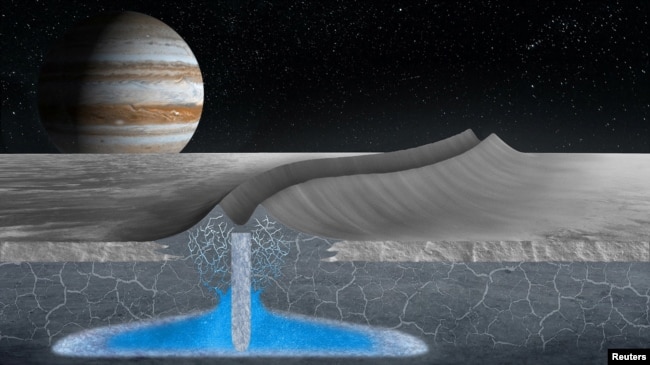エウロパ、そこに生命が?!
不確実性は残るものの、地球外生命体の飛来情報はあります。
地球以外の星に生命を見つけたいと望むのは、どうしてなのでしょうか?
生命の誕生・進化の解明?
人類の文明の存続可能期間を知るため?
移住先?
VOAで英語を学びましょう!!
木星の衛星エウロパ、地球と同じような地形が、生命存在条件を示唆 (和訳)
On Jupiter’s Moon Europa, Earth-like Landforms Suggest Conditions for Life
April 25,2022
エウロパの地形とグリーンランドの地形との類似性は、木星の月が生命を維持できるかもしれないことを示唆しています。
最近発表された研究では、エウロパの表面にある二重尾根と呼ばれる長い地形を、似ていますがグリーンランドにある小さな地形と比較しています。
二重尾根は、エウロパの表面を大きく切り裂いたように見えます。二重尾根は、2つの長い山の頂上とその間にある中央の谷を持っています。
スタンフォード大学の地球物理学者ライリー・カルバーグ氏は、Nature Communications誌に掲載されたこの研究の主執筆者です。この地形について、彼は、二重の尾根を切り開くと、大文字の "M" のように見えるだろうと述べています。
レーダーデータは、地表下の液体水の再凍結がグリーンランドの二重尾根の形成を促したことを示していました。
もし、エウロパの地層も同じように形成されたとしたら、エウロパの表面近くに大量の液体の水があることを意味するかもしれません。生命が存在するためには、液体の水が必要だと考えられているのです。
エウロパはこれまで、地球外の生命が存在する可能性がある場所として、科学者の注目を集めてきました。それは、氷に覆われたその表面の下に塩水の海があることを示唆する研究結果があるからです。
二重海嶺の表面近くにある小さな水の領域は、小さな生物が生息する第2の可能性のある場所となります。
「氷の殻の中に液体の水があるということは、海と氷の殻の間の交換が一般的であることを示唆しており、それは生命維持に役立つ化学的循環に重要である可能性があります。」とカルバーグ氏は語ります。また、将来の宇宙ミッションでは、深海よりも表層の水の方が研究しやすいだろうとも付け加えています。
米国の宇宙機関NASAは、木星の月にエウロパ・クリッパーという宇宙船を送ります。打ち上げは2024年の予定です。エウロパ・クリッパーの目的は、月が生命を維持できる条件を備えているかどうかを研究することです。
二重の尾根にある水は、表面から1キロメートル以内にあります。その場所は、生命の誕生を支える表面の化学物質に近いのです。
エウロパの大きさは3,100kmで、地球の月より少し小さいです。しかし、エウロパの海には、地球の海の2倍の量の水が含まれているかもしれません。地球で最初の生命は、海の中で見つかった小さな生物だったと科学者たちは考えています。
エウロパの二重の尾根は、時には数百キロメートルにも及びます。高さは150〜200メートルで、尾根の頂上は1.5〜1キロメートル離れています。
どのように形成されたのか、科学者たちは議論を重ねてきました。カルバーグ氏は、この地形がグリーンランド北西部の地形に似ていることに気がつきました。
カルバーグ氏は、グリーンランドの二重海嶺は、地表近くの水域が再凍結、加圧、破砕を繰り返すことによってできたものだと言います。さらに、地表近くの水も2つの体に分かれているため、2つの尾根があるのだと付け加えます。
もし同じプロセスでエウロパの二重の尾根ができたとしたら、それぞれの地表近くの水域は北米の五大湖の一つであるエリー湖と同じだけの水量になるかもしれません。
スタンフォード大学のダスティン・シュローダー教授は、この研究の執筆に協力しました。彼はこの水について、”この月を居住可能な非常にエキサイティングな候補にする”と指摘しています。
On Jupiter’s Moon Europa, Earth-like Landforms Suggest Conditions for Life
Similarities between formations on Europa and a landform in Greenland suggest Jupiter’s moon may be able to support life.
A study published recently compared long landforms called double ridges on Europa’s surface to similar but smaller landforms in Greenland.
The double ridges look like huge cuts across Europa’s surface. They have two long mountain tops and a central valley between them.
Stanford University geophysicist Riley Culberg is the lead writer of the study published in the publication Nature Communications. Describing the landforms, he said that if you cut through a double ridge, it would look like a capital “M.”
Radar data showed that refreezing of liquid water below the surface of the ground drove the formation of Greenland’s double ridge.
If Europa’s formations were created the same way, it might mean there are large amounts of liquid water near Europa’s surface. Liquid water is believed to be necessary for life to exist.
Europa has gained scientists’ attention in the past as a possible place for life outside of Earth. That is because research has suggested that a saltwater ocean is under its ice-covered surface.
Smaller areas of water closer to the surface in the double ridges would represent a second possible place for small organisms to live.
"The presence of liquid water in the ice shell would suggest that exchange between the ocean and ice shell is common, which could be important for chemical cycling that would help support life," Culberg said. He added that surface-level water would be easier for future space missions to study than the deep ocean.
The U.S. space agency NASA is sending a space vehicle called Europa Clipper to Jupiter’s moon. The launch is planned for 2024. Europa Clipper’s goal is to study if the moon has conditions able to support life.
The water in the double ridges is within one kilometer of the surface. Those areas are near chemicals on the surface that could support the formation of life.
Europa is 3,100 kilometers across, a little smaller than Earth’s moon. But Europa’s ocean might contain two times the amount of water that is in Earth’s oceans. Scientists believe that the first life on Earth was small organisms found in the ocean.
Europa’s double ridges are sometimes hundreds of kilometers long. They are 150 to 200 meters tall, and the tops of the ridges are one half to one kilometer apart.
Scientists have debated how they formed. Culberg noticed their similarity to a landform he knew in northwestern Greenland.
Culberg said the Greenland double ridge formation was created by repeated refreezing, pressurization, and fracturing of a near-surface body of water. He added that there are two ridges because the near-surface water is also split into two bodies.
If the same process created Europa’s double ridges, each near-surface body of water could have as much water as Lake Erie, one of North America’s Great Lakes.
Stanford geophysics professor Dustin Schroeder helped write the study. He noted that water “makes this moon a very exciting candidate for habitability…”
Words in This Story
ridge – n. a long area of land that is on top of a mountain or hill
cycle – v. to go through a repeated process or to cause (something) to go through a repeated process
mission – n. a flight by an aircraft or spacecraft to perform a specific task
fracture – v. to cause a crack or break in (something hard, such as a bone)
habitability – n. able to be or possible to live in

